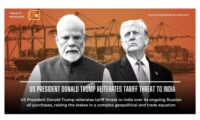- Home
- Latest Magazines
- Cover Stories
- World News
- News Station
- Business Insights
- Business Partnerships
- Industry Spotlights
- Education & Career
- Marketing & Advertising
- Human Resources
- Health Tech
- Big Data
- Cybersecurity
- Cryptocurrencies
- Cloud Computing
- Digital Payments
- Robotics
- Travel and Culture
- Small Business
- Tech Startups
- Internet of Things (IoT)
- Corporate Strategy
- Blogs
- Specials
- About Us
- Contact US
Marketing Playbook: 5 New Strategies for a New Era

The field of marketing in 2025 is changing faster than ever, thanks to new technology, altering customer expectations, and data-driven insights. To win in this new era of marketing, organizations must take innovative techniques that go beyond standard strategies.
The Entrepreneur Insights listed 2025 marketing playbook is meant to equip you with 5 new tactics to help your business succeed, backed up by practical tools, templates and insights from leading industry studies.
1. Gen AI in Marketing
Artificial Intelligence has moved from experimental to essential. In 2025, Generative AI (Gen AI) is transforming how marketers create, analyze, and deliver campaigns.
- Personalized Content at Scale: AI now enables brands to craft hyper-personalized emails, social media content, and landing pages for different customer segments without human limitations.
- Predictive Analytics: Marketers can anticipate customer needs, preferences, and purchase intent with greater accuracy, aligning offers with exact consumer behavior.
- Dynamic Ad Creative: AI-driven platforms allow real-time testing of ad variations, ensuring the most effective designs reach audiences.
By integrating Gen AI in marketing, businesses reduce time-to-market and deliver campaigns that resonate with unparalleled precision. The companies that leverage AI as co-creators, not just assistants, will lead in engagement and conversion rates.
2. Redefining Marketing Budgets for ROI
Gone are the days of static, one-size-fits-all budgets. Marketing budgets in 2025 must be fluid, agile, and performance-driven.
- Outcome-Based Allocation: Investments are now tied directly to measurable outcomes like pipeline growth, revenue impact, and retention metrics.
- Real-Time Reallocation: Tools enable dynamic redistribution of funds mid-campaign, ensuring money flows toward the most successful channels.
- Experimentation Reserves: Leading organizations allocate at least 10–15% of budgets for testing future marketing opportunities like immersive reality and AI-powered chat campaigns.
By tracking Cost per Acquisition (CPA) and Customer Lifetime Value (CLV), marketers can justify every dollar spent and confidently adjust spending toward the highest ROI activities.
3. Future Marketing: Experience-First Engagement
The future of marketing lies in creating experiences, not just delivering messages. In 2025, experience-first marketing has become the gold standard.
- Immersive AR & VR Journeys: Retailers are using Augmented and Virtual Reality to offer virtual product trials, creating emotional connections before purchase.
- Phygital Strategies: The blend of physical and digital channels allows brands to deliver seamless customer experiences, from interactive store kiosks to app-based loyalty programs.
- Community-Centric Campaigns: Brands are shifting focus from one-off sales to building long-term brand communities where customers become advocates.
Experience-first strategies differentiate brands in saturated markets, ensuring customer loyalty and retention.
4. Leveraging Gartner Marketing Maturity Assessment for Growth
To win in 2025, companies must benchmark their marketing effectiveness against industry standards. The Gartner Marketing Maturity Assessment has become a key tool for this.
- Capability Mapping: Brands use the assessment to identify gaps in content strategy, analytics, customer journey management, and omnichannel execution.
- Strategic Roadmaps: Based on maturity levels, marketing leaders can prioritize investments whether in automation, AI, or advanced personalization.
- Performance Transparency: By aligning with Gartner’s frameworks, CMOs provide executives with measurable progress benchmarks.
Incorporating maturity assessments ensures marketing departments remain agile and competitive in a rapidly transforming environment.
5. Smarter Planning with Marketing Strategy Templates
In 2025, businesses no longer start from scratch. A marketing plan 2025 template offers the structure and flexibility needed for agile execution.
- Unified Frameworks: Templates help align brand goals, audience segmentation, channel strategy, and KPIs in a single, actionable document.
- Marketing Strategy Examples: From B2B SaaS companies to consumer retail, successful examples of modern marketing strategies demonstrate how a clear plan accelerates success.
- Customizable for Scale: Whether a startup or enterprise, these templates adapt to business size, allowing for easy updates as campaigns evolve.
Using a marketing strategy template not only saves time but ensures consistency across teams and departments, enabling businesses to execute campaigns more effectively.
Marketing Strategy Examples for 2025 Success
- B2B SaaS Example: Leveraging AI-driven account-based marketing (ABM) with predictive lead scoring.
- Retail Example: Combining influencer partnerships with immersive AR shopping experiences.
- Healthcare Example: Deploying data-driven personalization in wellness apps to boost engagement and retention.
Each of these marketing strategy examples shows how innovation can be directly tied to business growth.
How to Build Your 2025 Marketing Plan
To implement these five strategies effectively, businesses should follow a step-by-step process:
- Conduct a Maturity Assessment: Understand where your organization stands today.
- Set SMART Goals: Align business objectives with measurable marketing outcomes.
- Adopt Gen AI Tools: Automate personalization, analytics, and creative generation.
- Allocate Dynamic Budgets: Ensure flexibility and reserve funds for innovation.
- Deploy Templates: Use a marketing plan 2025 template to streamline execution.
The Road Ahead: Marketing in a New Era
The 2025 marketing strategy focuses on embracing transformation rather than incremental improvements. Organizations that implement these techniques, from Gen AI in marketing to experience-first engagement, will position themselves for future growth.
This new era requires agility, inventiveness, and data-driven decision-making. Those that prepare now will be the market leaders of tomorrow.
Explore more
Celebrate Labor Day 2025 with parades, shopping deals and community events
“The Entrepreneur Insights” – informative, concise, friendly, and inspiring. Provide readers with everything they need to know about Labor Day 2025 — meaning,...










Leave a comment